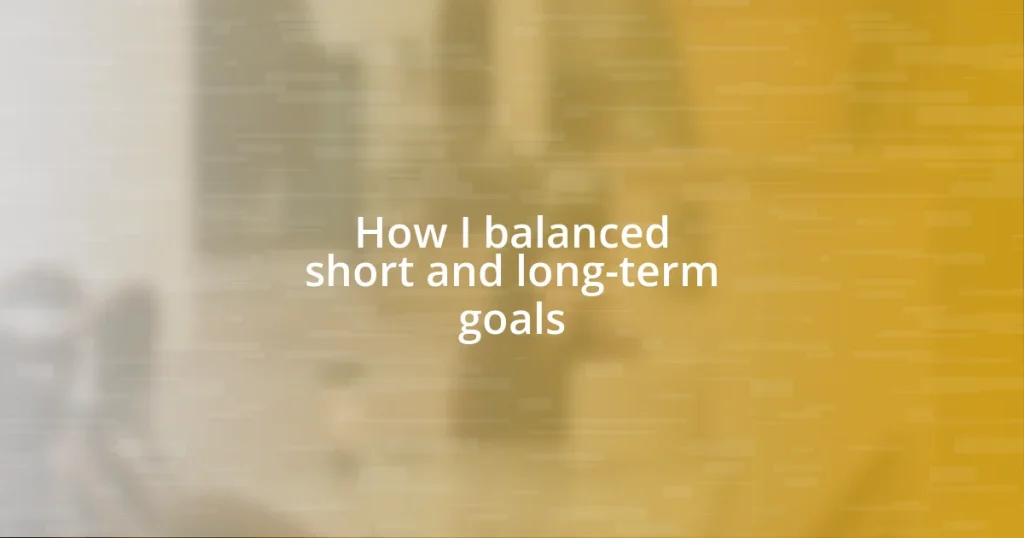Key takeaways:
- Balancing short-term and long-term goals is essential for personal and professional fulfillment, as each type supports and enriches the other.
- Effective prioritization and time management strategies, such as listing tasks, categorizing by urgency, and using time-blocking, enhance goal achievement.
- Adjusting goals is a natural part of progress; maintaining flexibility and seeking support from others can lead to sustainable growth and fulfillment.

Understanding short and long-term goals
Understanding short and long-term goals is crucial for anyone striving for success. Short-term goals are often those stepping stones toward our larger aspirations, like completing a project or acquiring a new skill within weeks or months. I remember when I set a short-term goal to learn a new software program for work; it felt manageable and immediately rewarding, boosting my confidence along the way.
Long-term goals, on the other hand, often span years and require more persistence. I’ve found that these goals, like aiming for a promotion or saving for a home, give my everyday actions a deeper purpose. Have you ever pondered how a single long-term goal can influence many short-term decisions? When I kept my bigger vision in mind, it helped me tackle each day’s challenges with renewed vigor and clarity.
Balancing these two types of goals can feel overwhelming at times, but it can lead to a fulfilling journey. Picture a tree: the roots represent your long-term goals, anchoring you down, while the branches embody your short-term goals, reaching for light and growth. This analogy resonates with me because, much like nurturing a plant, cultivating both types of goals requires attention and care, but the results are incredibly rewarding.

Importance of balancing goals
Balancing goals is essential for maintaining perspective in both your personal and professional life. When I think about my journey, I recall how setting a short-term goal to read a book each month kept me motivated and engaged. This immediate satisfaction complemented my long-term ambition of becoming a well-rounded professional, showing me how small wins can build momentum toward my ultimate objectives.
On the flip side, neglecting to balance these goals can lead to burnout. I vividly remember a phase when I focused solely on long-term aspirations like furthering my career, to the detriment of my mental well-being. I became so engrossed in future rewards that I started to lose sight of everyday joys, such as spending quality time with friends and family. It made me realize that both short and long-term goals must coexist; each enriches the other.
Finally, ensuring a balance between short-term and long-term goals fosters adaptability. When unexpected challenges arise, like those moments when a sudden project demands your full attention, having that groundwork of short-term achievements allows you to pivot more easily. I’ve learned that when I create space for flexibility within my goals, I can embrace change, which ultimately leads to growth.
| Short-Term Goals | Long-Term Goals |
|---|---|
| Provide immediate satisfaction | Offer a sense of direction and purpose |
| Boost daily motivation | Require ongoing commitment and resilience |
| Easier to adjust and track | Help in making significant life decisions |

Strategies for setting priorities
Setting priorities is crucial when balancing short-term and long-term goals. I’ve found that starting with a clear list helps to clarify what matters most. Whenever I feel overwhelmed, I often reflect on my goals using a simple framework of urgency versus importance. This approach allows me to identify tasks that align best with my aspirations, focusing on what will propel me forward.
Here’s a quick breakdown of strategies that work for me:
- Make a List: Jot down all tasks, both short and long-term. Getting everything on paper reduces mental clutter.
- Categorize: Divide tasks into urgent, important, and non-urgent categories. This helps me see what deserves immediate attention.
- Set Deadlines: Assign realistic deadlines to keep myself accountable. I’ve discovered that deadlines help me avoid procrastination and create a sense of urgency.
- Review Regularly: I set aside time weekly to reassess my priorities. This reflection fosters flexibility, ensuring that I adapt as new opportunities or challenges arise.
- Align with Values: I frequently ask myself if the goals truly reflect my core values. This check-in reinforces my motivation since it connects my daily actions with my personal beliefs.
In my experience, using these strategies has transformed how I approach my goals. It feels incredibly empowering to see my priorities clearly laid out, which helps me maintain a balanced focus on both short-term wins and long-term aspirations.

Time management techniques for goals
When it comes to time management techniques for achieving my goals, I’ve always leaned towards creating a structured routine. One of my favorite methods is implementing the Pomodoro Technique, where I work in focused bursts of 25 minutes followed by a 5-minute break. This approach not only minimizes distractions but also keeps my energy levels high. Have you ever noticed how taking short breaks can actually boost your productivity? I’ve found that after a quick stretch or a sip of water, I return to tasks with fresh perspectives.
Another technique that has worked wonders for me is time blocking. I allocate specific chunks of my day to focus on particular tasks, whether they’re short-term projects or long-term plans. By blocking out time on my calendar, I create a clear visual roadmap for my day, preventing me from getting sidetracked by less critical tasks. Surprisingly, this discipline invites a sense of accomplishment, as I can easily see what I’ve tackled. Have you ever tried setting time limits for tasks? The deadlines can surprisingly encourage efficiency and give a clearer sense of progress.
Lastly, I emphasize the importance of reflection in my time management process. At the end of each week, I take a moment to review how well I balanced my activities. This ritual helps me to understand what worked and what needs adjustment. I often ask myself questions like, “Did I allocate enough time to my long-term projects?” and “What can I change to improve next week?” This habit not only keeps me accountable but also reinforces my commitment to both short and long-term goals. It feels enriching to acknowledge my progress while also nurturing areas where I can grow.

Tools for tracking progress
Tracking progress is essential for balancing goals effectively, and I’ve discovered several tools that help me stay on course. One of my go-to methods is using a digital app designed for goal tracking. I like how it allows me to break down my long-term goals into smaller, actionable steps. It’s satisfying to check off each task. Have you ever experienced that rush of accomplishment? It’s like a mini celebration every time I mark something as complete.
Another tool in my arsenal is a physical planner. I relish the tactile experience of writing down my tasks and notes. Each week, I dedicate some time to reflect on what I’ve accomplished and what still needs attention. I can’t help but feel a sense of pride when I review my entries — it’s a visual reminder of how far I’ve come. Plus, flipping through pages filled with my thoughts and ideas gives me a sense of direction. It’s almost therapeutic, and I highly recommend trying it if you haven’t yet.
Lastly, I enjoy utilizing spreadsheets for more in-depth tracking, especially for long-term projects that require detailed analysis. Setting up a simple tracker with columns for progress, deadlines, and reflections has been incredibly beneficial. I often find myself revisiting these spreadsheets to adjust timelines or reassess priorities. Have you ever found insights in your data that changed your perspective? For me, those moments clarify what needs more focus and ensure I’m not overlooking anything crucial on my journey.

Adjusting goals as needed
Adjusting goals is a natural part of the journey, and I can’t stress enough how essential it is to stay flexible. When I set out to achieve my long-term goal of writing a book, I realized halfway through that my initial timeline was unrealistic. Sometimes, life throws unexpected challenges my way, and I’ve learned to reassess my deadlines. Have you ever had to push back a goal? It can feel disheartening, but it’s also an opportunity to refine your approach and focus on what truly matters.
One tactic I’ve found effective is setting regular check-ins, not just with myself, but sometimes with a trusted friend or mentor. When I was knee-deep in my book project, I scheduled monthly meetings to discuss my progress. These conversations helped me identify areas where I was struggling and adjust my goals accordingly. There’s something reassuring about voicing your challenges; it can shift your perspective and make the adjustments feel more manageable. What about you? Do you have someone who can help you navigate these adjustments?
I also keep a flexible mindset during my goal-setting process. For example, while working towards a fitness milestone, I discovered that my approach needed adjustment after experiencing burnout. Instead of pushing through it, I acknowledged these feelings and modified my workout plan to include more rest days. I felt relieved and energized by the changes, which ultimately made my progress more sustainable. Isn’t it refreshing when we allow ourselves to adapt? Adjusting goals isn’t about failure; it’s about growth and honoring our well-being in the pursuit of our aspirations.

Real-life examples of balance
During my journey of balancing short and long-term goals, I found inspiration in a friend’s approach to saving money. She wanted to buy a house one day, but she also loved traveling. Instead of seeing these goals as conflicting, she created a savings plan that allowed room for both. She committed to a certain percentage of her income for her future home while simultaneously setting aside a smaller amount for spontaneous trips. Witnessing her joy in achieving both aspirations made me realize that with careful planning, it’s entirely possible to enjoy the journey while keeping an eye on the bigger picture. Have you ever felt torn between two passions?
I also recall collaborating with a colleague on an ambitious project at work. We aimed for a significant promotion, which required both immediate results and long-term innovation. To balance these demands, we split our tasks into urgent deliverables for our manager and exploration time for our creative ideas. This method allowed us to meet immediate expectations while also nurturing our vision. Isn’t it fascinating how collaboration can spark new insights? That balance not only improved our performance but also fostered a sense of camaraderie that made our work enjoyable.
On a personal note, I’ve ventured into gardening as a way to balance my goals. While my long-term vision is to cultivate a flourishing vegetable garden, I’ve started with just a few pots on my balcony. Each week, I dedicate time to care for my plants, reveling in their progress while still managing my busy schedule. There’s something satisfying about nurturing those little sprouts, and it reminds me that growth can happen in stages. Have you ever tried a hobby that unexpectedly aligned with your broader ambitions? For me, this balanced approach has been both fulfilling and rejuvenating, proving that patience truly pays off.















